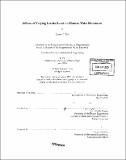Effects of varying inertial load on human wrist movement
Author(s)
Kai, Lauren C. (Lauren Catherine)
DownloadFull printable version (2.575Mb)
Other Contributors
Massachusetts Institute of Technology. Dept. of Mechanical Engineering.
Advisor
Neville Hogan.
Terms of use
Metadata
Show full item recordAbstract
To study natural wrist movements in human subjects, a magnetic motion sensing system was employed to document unimpeded motion. Three identical bottles of different weights were designed as handles to provide a wide range of inertial loads. Subjects executed a series of horizontal and vertical moves with each bottle at two different speeds. Hypotheses concerning the effects of increased load on target overshoot, maximum acceleration and speed, and hand tremors were tested. The frequency content seen in the natural speed trials was found to resemble a normal distribution. This higher area of frequency content could potentially correlate with the frequency of hand tremors. After analysis of overshoot, there was found to be no statistical difference in the percent overshoot of movements by varying the weight of the handles. The data showed that the highest accelerations and speeds of the empty bottle were faster than those of the medium weight or the heavy weight bottle. One possible interpretation of this is that human wrist movement is force limited and there is a maximum acceleration at which humans can move.
Description
Thesis (S.B.)--Massachusetts Institute of Technology, Dept. of Mechanical Engineering, 2005. Includes bibliographical references (p. 44).
Date issued
2005Department
Massachusetts Institute of Technology. Department of Mechanical EngineeringPublisher
Massachusetts Institute of Technology
Keywords
Mechanical Engineering.